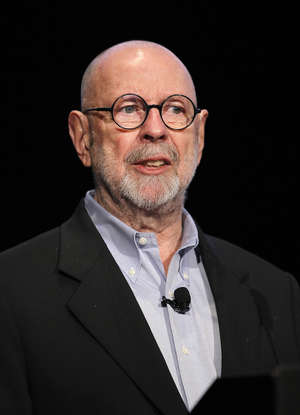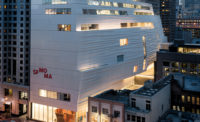
Photo © Tony Avelar/Bloomberg
Participating in a panel discussion at Bloomberg Businessweek Design 2013 are, from left, Josh Tyrangiel, editor at Bloomberg Businessweek; Jeanne Gang, founder and principal of Studio Gang Architects; Ada Tolla and Giuseppe Lignano, founders of LOT-EK; Thom Mayne, founder of Morphosis Architects; Peter Walker, founder and partner at PWP Landscape Architecture; and Janette Sadik-Khan, commissioner at New York City Department of Transportation.
At a time when the notion of omniscient master architects is seen by many critics as passé, a day-long design conference in San Francisco suggested that the concept remains in vogue with the wider public.
 |
|
Photo © Tony Avelar/Bloomberg
Peter Walker, founder and partner at PWP Landscape Architecture, speaks during the Bloomberg Businessweek Design 2013 conference in San Francisco.
|
The forum was the first annual Bloomberg Businessweek Design 2013, held on January 14 at Herzog & de Meuron’s M.H. de Young Memorial Museum and billed by the magazine as a gathering “where the world’s top designers and creative executives discuss ways design makes the world better, smarter, and more innovative.” The opening session was on cities and featured “the Oceans Eleven of urban design,” in the words of Bloomberg Businessweek editor Josh Tyrangiel: New York City transportation commissioner Janette Sadik-Khan, landscape architect Peter Walker, and architects Jeanne Gang, Thom Mayne, and the founders of LOT-EK, Ada Tolla and Giuseppe Lignano.
Most of the session consisted of individual presentations, 15-minute segments that veered from broad observations to, at moments, the canned focus of a business pitch light on theory and heavy on images. For instance, Mayne began his quarter hour by announcing, “the city is the most compelling problem we face in the 21st Century … it requires a complete new thinking that recognizes the challenge of contemporary society.” But then he shifted to showing off examples of his firm Morphosis’ work from the past decade. By the time Mayne reached the planned second half of his talk – large-scale urbanism – only three allotted minutes remained. “Boy, 15 minutes is a killer for the city, I tell you,” he said.
LOT-EK’s Tolla and Lignano weren’t nearly so ambitions. The former conveyed aspects of the firm’s philosophy in purposefully provocative terms (“we find a certain tough beauty in a violent precision”). Lignano followed with a project that, invariably, turned shipped containers into something quite different, beginning with a globetrotting pop-up store for Puma.
Gang laid out the most cohesive set of theories, arguing that America must “expand the definition of infrastructure beyond thinking about bridges and roads and instead think about vertical community, environmental community, a just community.” Within that context came her designs, from an inner-city youth center in Chicago and a migratory bird habitat on Lake Michigan to a newly designed tower that is shaped to preserve sunlight along Manhattan’s High Line – an example of what Gang described as her quest for “architecture that increases the desirability of compact urban living.”
The final two speakers broadened the approach. Landscape architect Peter Walker augmented highlights of his half-century career with iconic examples of the nation’s shifting expectations of the civic terrain, spanning eras from the central lawn of the University of Virginia to Chicago’s Millennium Park and the High Line. As for Sadik-Kahn, her recounting of New York City’s new emphasis on bike lanes and the conversion of traffic lanes to pedestrian space was catnip to an audience in synch with such declarations as: “By being able to move quickly, we were able to show the world what was possible.”
The most rewarding segment was the too-brief finale when the sextet gathered on stage and fielded questions from Tyrangiel. Asked to name a common trait of successful cities, Gang suggested “hardware and software. Spaces, but also the events that make a place unique.” Lignano and Mayne bemoaned America’s perceived constraints on adventurous architecture, with Lignano saying, “codes and tools have to evolve as needs change. Rules meant to ensure ‘quality’ can be a hindrance.” Walker, the veteran, was more pragmatic: “Patronage. Cities that succeed need a lot of money that can’t come out of the tax roll. A lot of things in cities get worn down, and they need upkeep and care.”




Post a comment to this article
Report Abusive Comment